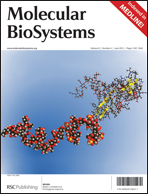Insertion of T4-lysozyme (T4L) can be a useful tool for studying olfactory-related GPCRs†
Abstract
The detergents used to solubilize GPCRs can make crystal growth the rate-limiting step in determining their structure. The Kobilka laboratory showed that insertion of T4-lysozyme (T4L) in the 3rd intracellular loop is a promising strategy towards increasing the solvent-exposed receptor area, and hence the number of possible lattice-forming contacts. The potential to use T4L with the olfactory-related receptors hOR17-4 and hVN1R1 was thus tested. The structure and function of native and T4L-variants were compared. Both receptors localized to the cell membrane, and could initiate ligand-activated signaling. Purified receptors not only had the predicted alpha-helical structures, but also bound their ligands canthoxal (MW = 178.23) and myrtenal (MW = 150.22). Interestingly, the T4L variants had higher percentages of soluble monomers compared to protein aggregates, effectively increasing the protein yield that could be used for structural and function studies. They also bound their ligands for longer times, suggesting higher receptor stability. Our results indicate that a T4L insertion may be a general method for obtaining GPCRs suitable for structural studies.


 Please wait while we load your content...
Please wait while we load your content...